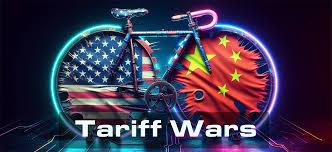How do Tariffs Affect the Bicycle Industry
How Do Tariffs Affect the Bike Industry
The recent changes in economic policy are creating uncertainty in many people’s lives. At Fit Werx, we are closely monitoring the situation regarding tariffs and bicycle products with varying levels of concern. Here is what we understand and what we believe at the moment.
Where Do Our Bikes Come From?
The bicycle industry is a global market. Bicycles are imported into the United States from well-known countries like China and Taiwan, as well as lesser-known locations such as Cambodia and Portugal. Some of our partners import complete bikes, while others bring in frames and parts separately. Additionally, several partners, including Moots, Parlee, Enve, and White Industries/Rolf, manufacture a significant portion of their products in the United States.
From 2016 to 2020, tariffs on Chinese products increased. This caused many bike manufacturers to relocate some of their production outside China. Many of the new production facilities were designed to manufacture enthusiast-level bikes. Even with this change in manufacturing locations, China continues to be the largest importer of bicycles to the United States. Because of this, tariffs on China could have a larger impact on the bicycle industry than tariffs on any other country.
What About the Components?
Some of our suppliers, such as Cervelo, Niner, and Orbea, import bikes as complete items. In this context, small parts such as chains and cassettes are considered part of the whole unit. Other suppliers, like Moots, Parlee, and other frame-first companies, build their frames in one place and import their parts from various other suppliers and countries. Although some component manufacturers moved out of China in 2016-2020, there is still a large manufacturing presence in China.
Chains are a good example of the global breadth of the bicycle industry. The three biggest manufacturers of bicycle chains are SRAM, Shimano, and KMC. SRAM manufactures its chains in Portugal, Shimano manufactures its chains in Japan, and KMC chains come from Taiwan. To add to potential tariff confusion, all three companies provide chains to companies like CeramicSpeed, a well-known performance parts upgrade company. These chains are optimized in a factory in Denmark and then sold worldwide. In any given bike shop, there could be chains from all four suppliers. Each one could have been subject to a different tariff when imported.
Currently, China is the center of tariff discussions for the bike industry. However, it is worth remembering that tariffs are in place in many countries. The disjointed nature of production in the bicycle industry adds to the difficulty of understanding and predicting how and when tariffs could affect it.
What Products and When
Numerous tariffs have been proposed and it seems fruitless to try to stay aware of every possible tariff and its effects. Adding to this difficulty, each tariff is negotiable and variable. Some proposed tariffs might not get implemented. This said, currently, two proposed tariffs appear to potentially impact the bicycle industry in the near-term.
One is on aluminum and steel and will start on March 12, 2025. This is a very broad tariff affecting many countries. Since every bicycle has parts manufactured from aluminum or steel, every bike company faces exposure to these tariffs. At the moment, the United States does not have the capacity to meet steel or aluminum demand with U.S. based production. The companies that build their bikes in the United States from imported steel or aluminum will likely feel the impact as their current inventory depletes.
The other proposed tariff is an additional 10% tariff on products from China set to begin the second week of March. As noted above, China is the largest importer of bicycles to the US market. Because of this, the additional tariff appears poised to impact the overall bicycle market.
What is unknown is that other tariffs could be implemented (or removed) in the future, making planning for the future difficult.
What Should I Do About Tariffs?
The short answer is, “Start to accept them”. The longer answer is that the timing and type of tariffs are unknown at the moment. It seems that the administration is trying to replace a fair amount of revenue that has traditionally come from other sources, like income and payroll taxes, with tariffs. If this happens, tariffs may just become the reality of how much of the government is funded moving forward. Regardless, it seems likely that some new and increased tariffs will be implemented in the future that will affect enthusiast-level bicycles. We see it as unprobable that bike prices will go down in the foreseeable future, and they will likely go up. Prices are likely as low as they will be for the foreseeable future. If you are considering a bike, getting it on order is the best possible way to stay ahead of any increased costs associated with tariffs.
Contact us today to find out what fits you well and to discuss the best options for your use and budget.

